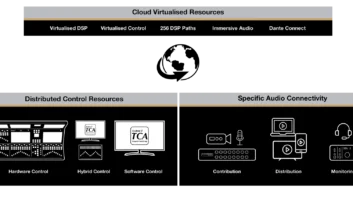
Media organisations have been pushed by the current unpredictable media environment to evolve quicker than ever before in order to keep up with technological advancements and consumer demands. As a result, the industry has seen media organisations strategically revise their technology systems, which, in turn, have made production processes more intelligent. Not only has this been achieved by investing in the latest market-leading technology, but also by outgrowing hardware-defined systems that have left broadcasters restricted in terms of capacity, connectivity and cost control.
Extending beyond the option of accessing, downloading, and delivering content from a physical data centre can eliminate these inherent economic and workflow challenges, and open the opportunity for companies to work with greater flexibility and efficiency. The key component enabling this growth is cloud technology. As we head into another year, companies need to prepare for the future and keep up with industry and audience pressures by virtualising their storage in the cloud.
Expanding workflow potential
Migrating storage to the cloud helps media organisations such as broadcasters and pay-TV operators achieve their strategic technology objectives and business goals. Acquiring powerful cloud-driven storage allows companies to overcome costly workarounds, and successfully tackle accessibility problems, security issues, and slow file transfer rates. The up-front investments and cash outlays needed to prepare and use storage in a physical data centre can be suppressed as cloud storage costs can be aligned with usage. Costs are distributed with confidence, permitting organisations to scale out or scale back their cloud storage usage as needed.
How production teams access and retrieve content from the cloud is dependent on how the organisation operates internally – from entire enterprise network-based activity to smaller team-based/individual projects. Options, ranging from the public, on-premises, and private cloud, mean companies can work freely – allowing users to move content to, from and across the cloud seamlessly without knowledge of the underlying storage type or location and without affecting the user’s experience or workflow.
However, with the understanding that some content needs to remain on-premises so customers and partners can access the files without having to migrate to the cloud, media organisations are able to become hybrid cloud adopters – a popular option we expect to see grow as cloud storage standardises across the industry. Supported by Aspera Files, a cloud-powered SaaS platform enabling fast and secure large file delivery from anywhere to anywhere, the hybrid cloud offers greater flexibility – allowing organisational teams to work under several cloud storage systems belonging to one unified cloud network.
The rapid emergence of cloud technology as a key industry gamechanger is partially driven as a response to audience demand for quality of experience and content immediacy. And with an increase in multi-platform TV viewing, multisite workflows, and larger file sizes, it’s more crucial than ever to adopt a cloud-based storage system which that protects content and delivers it glitch- and delay-free, while building audience trust and loyalty in the highest-quality viewing experiences..
With collaboration and file sharing prevalent within media production, cloud security is crucial. The request to keep certain types of content within all four walls of media organisations’ data centres for improved security and control is still a concern – a feeling generally propagated by limited knowledge of the many cloud storage options available. As cloud storage popularity surges, we will see cloud storage become a common asset within companies’ workflow in the very near future. And with this comes the knowledge of the cloud’s flexibility and scalable infrastructure to adapt to companies’ existing technical setups. With Aspera Files, it’s simple to migrate from outdated hardware or another cloud supplier to the cloud by triggering a secure, direct and high-speed data transfer to your new cloud storage.
The next-generation of cloud storage
New modern SaaS services like Aspera Files are multi-cloud, meaning they run on and are directly integrated into the leading cloud storage platforms such as AWS, Azure, IBM Cloud, and Google Cloud. At Aspera we expect compatibility across cloud suppliers to grow as cloud storage users do.
Media production – considering evolving formats such as 4K, virtual reality and live streaming – will continue to challenge cloud storage suppliers with a multitude of file types and sizes. With this comes new production timelines and processes introduced to the delivery chain, which cloud storage suppliers must be prepared to address.
2017 saw cloud storage adoption pick up pace significantly as media organisations’ impatience towards streamlining production through cloud technology grew. In 2018, cloud-based storage will continue to gain momentum as the media industry’s biggest players prepare for a future of efficient, reliable, and scalable cloud-powered workflows.







